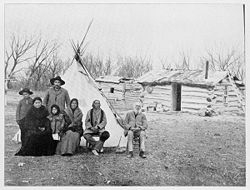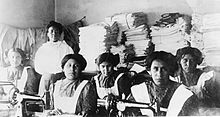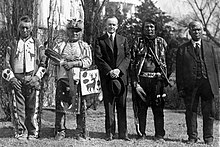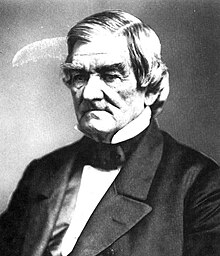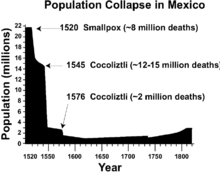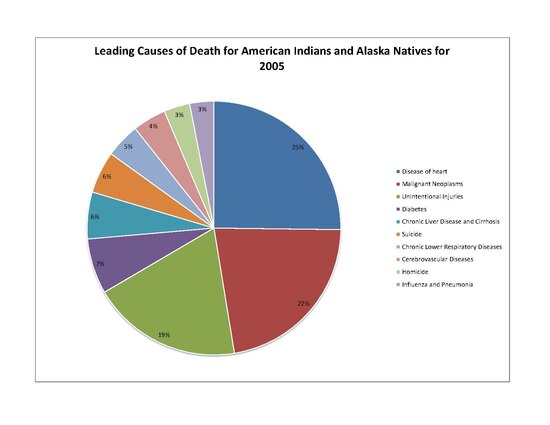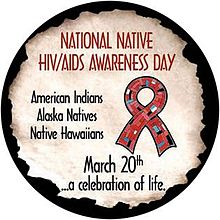Alaska Native dancers at the University of Alaska, Fairbanks Art Museum, 2006
Caddo members of the Caddo Cultural Club, Binger, Oklahoma, 2008
Native American writers Kim Shuck (Cherokee-Sac and Fox), Jewelle Gomez (Iowa), L. Frank (Tongva-Acjachemen) and Reid Gómez (Navajo)
Native American identity in the United States is an evolving topic based on the struggle to define "Native American"
or "(American) Indian" both for people who consider themselves Native
American and for people who do not. Some people seek an identity
that will provide for a stable definition for legal, social, and
personal purposes. There are a number of different factors which have
been used to define "Indianness," and the source and potential use of
the definition play a role in what definition is used. Facets which
characterize "Indianness" include culture, society, genes/biology, law, and self-identity.
An important question is whether the definition should be dynamic and
changeable across time and situation, or whether it is possible to
define "Indianness" in a static way.
The dynamic definitions may be based in how Indians adapt and adjust
to dominant society, which may be called an "oppositional process" by
which the boundaries between Indians and the dominant groups are
maintained. Another reason for dynamic definitions is the process of "ethnogenesis",
which is the process by which the ethnic identity of the group is
developed and renewed as social organizations and cultures evolve. The question of identity, especially aboriginal identity, is common in many societies worldwide.
The future of their identity is extremely important to Native Americans. Activist Russell Means
spoke frequently about the crumbling Indian way of life, the loss of
traditions, languages, and sacred places. He was concerned that there
may soon be no more Native Americans, only "Native American Americans,
like Polish Americans and Italian Americans."
As the number of Indians has grown (ten times as many today as in
1890), the number who carry on tribal traditions shrinks (one fifth as
many as in 1890), as has been common among many ethnic groups over time.
Means said, "We might speak our language, we might look like Indians
and sound like Indians, but we won’t be Indians."
Definitions
There
are various ways in which Indian identity has been defined. Some
definitions seek universal applicability, while others only seek
definitions for particular purposes, such as for tribal membership or
for the purposes of legal jurisdiction.
The individual seeks to have a personal identity that matches social
and legal definitions, although perhaps any definition will fail to
categorize correctly the identity of everyone.
American Indians were perhaps clearly identifiable at the turn of
the 20th century, but today the concept is contested. Malcolm
Margolin, co-editor of News From Native California muses, "I don’t know what an Indian is... [but] Some people are clearly Indian, and some are clearly not." Cherokee Chief (from 1985–1995) Wilma Mankiller
echoes: "An Indian is an Indian regardless of the degree of Indian
blood or which little government card they do or do not possess."
Further, it is difficult to know what might be meant by any Native American racial identity. Race is a disputed term, but is often said to be a social (or political) rather than biological construct. The issue of Native American racial identity was discussed by Steve Russell
(2002, p68), "American Indians have always had the theoretical option
of removing themselves from a tribal community and becoming legally
white. American law has made it easy for Indians to disappear because
that disappearance has always been necessary to the 'Manifest Destiny'
that the United States span the continent that was, after all,
occupied." Russell contrasts this with the reminder that Native
Americans are "members of communities before members of a race."
Traditional
Reservation
life has often been a blend of the traditional and the contemporary. In
1877, this Lakota family living at South Dakota's Rose Bud Agency had
both tipis and log cabins.
Traditional definitions of "Indianness" are also important. There is
a sense of "peoplehood" which links Indianness to sacred traditions,
places, and shared history as indigenous people. This definition transcends academic and legal terminology. Language is also seen as an important part of identity, and learning Native languages, especially for youth in a community, is an important part in tribal survival.
Some Indian artists find traditional definitions especially important. Crow poet Henry Real Bird
offers his own definition, "An Indian is one who offers tobacco to the
ground, feeds the water, and prays to the four winds in his own
language." Pulitzer Prize-winning Kiowa author N. Scott Momaday
gives a definition that is less spiritual but still based in the
traditions and experience of a person and their family, "An Indian is
someone who thinks of themselves as an Indian. But that's not so easy
to do and one has to earn the entitlement somehow. You have to have a
certain experience of the world in order to formulate this idea. I
consider myself an Indian; I've had the experience of an Indian. I know
how my father saw the world, and his father before him."
Constructed as an imagined community
Some
social scientists relate the uncertainty of Native American identity to
the theory of the constructed nature of identity. Many social
scientists discuss the construction of identity. Benedict Anderson's "imagined communities"
are an example. However, some see construction of identity as being
part of how a group remembers its past, tells its stories, and
interprets its myths. Thus cultural identity
is made within the discourses of history and culture. Identity thus
may not be a fact based in the essence of a person, but a positioning,
based in politics and social situations.
Blood quantum
A
common source of definition for an individual's being Indian is based
on their blood (ancestry) quantum (often one-fourth) or documented
Indian heritage. Almost two-thirds of all Indian federally recognized
Indian tribes in the United States require a certain blood quantum for
membership. Indian heritage is a requirement for membership in most American Indian Tribes. The Indian Reorganization Act
of 1934 used three criteria: tribal membership, ancestral descent, and
blood quantum (one half). This was very influential in using blood
quantum to restrict the definition of Indian. The use of blood quantum is seen by some as problematic as Indians marry out to other groups at a higher rate than any other United States ethnic or racial category. This could ultimately lead to their absorption into the rest of multiracial American society.
Residence on tribal lands
BIA map of reservations in the United States
Related to the remembrance and practice of traditions is the residence on tribal lands and Indian reservations.
Peroff (2002) emphasizes the role that proximity to other Native
Americans (and ultimately proximity to tribal lands) plays in one's
identity as a Native American.
Construction by others
Students at the Bismarck Indian School in the early twentieth century.
European conceptions of "Indianness" are notable both for how they
influence how American Indians see themselves and for how they have
persisted as stereotypes which may negatively affect treatment of
Indians. The noble savage stereotype is famous, but American colonists
held other stereotypes as well. For example, some colonists imagined
Indians as living in a state similar to their own ancestors, for example
the Picts, Gauls, and Britons before "Julius Caesar with his Roman legions (or some other) had ... laid the ground to make us tame and civil."
In the 19th and 20th century, particularly until John Collier's
tenure as Commissioner of Indian Affairs began in 1933, various
policies of the United States federal and state governments amounted to
an attack on Indian cultural identity and attempt to force assimilation.
These policies included but were not limited to the banning of
traditional religious ceremonies; forcing traditional hunter-gatherer
people to begin farming, often on land that was unsuitable and produced
few or no crops; forced cutting of hair; coercing "conversion" to Christianity by withholding rations; coercing Indian parents to send their children to boarding schools where the use of Native American languages was not permitted; freedom of speech restrictions; and restricted allowances of travel between reservations.
In the Southwest sections of the U.S. under Spanish control until
1810, where the majority (80%) of inhabitants were Indigenous, Spanish
government officials had similar policies.
United States government definitions
President Coolidge stands with four Osage Indians at a White House ceremony
Some authors have pointed to a connection between social identity of
Native Americans and their political status as members of a tribe. There are 561 federally recognized tribal governments in the United States, which are recognized as having the right to establish their own legal requirements for membership.
In recent times, legislation related to Indians uses the "political"
definition of identifying as Indians those who are members of federally
recognized tribes. Most often given is the two-part definition: an
"Indian" is someone who is a member of an Indian tribe and an "Indian
tribe" is any tribe, band, nation, or organized Indian community
recognized by the United States.
The government and many tribes prefer this definition because it
allows the tribes to determine the meaning of "Indianness" in their own
membership criteria. However, some still criticize this saying that the
federal government's historic role in setting certain conditions on the
nature of membership criteria means that this definition does not
transcend federal government influence.
Thus in some sense, one has greater claim to a Native American
identity if one belongs to a federally recognized tribe, recognition
that many who claim Indian identity do not have.
Holly Reckord, an anthropologist who heads the BIA Branch of
Acknowledgment and Recognition, discusses the most common outcome for
those who seek membership: "We check and find that they haven't a trace
of Indian ancestry, yet they are still totally convinced that they are
Indians. Even if you have a trace of Indian blood, why do you want to
select that for your identity, and not your Irish or Italian? It's not
clear why, but at this point in time, a lot of people want to be
Indian.".
The Arts and Crafts Act
of 1990 attempts to take into account the limits of definitions based
in federally recognized tribal membership. In the act, having the
status of a state-recognized Indian tribe is discussed, as well as
having tribal recognition as an "Indian artisan" independent of tribal
membership. In certain circumstances, this allows people who identify
as Indian to legally label their products as "Indian made", even when
they are not members of a federally recognized tribe. In legislative hearings, one Indian artist, whose mother is not Indian but whose father is Seneca
and who was raised on a Seneca reservation, said, "I do not question
the rights of the tribes to set whatever criteria they want for
enrollment eligibility; but in my view, that is the extent of their
rights, to say who is an enrolled Seneca or Mohawk or Navajo or Cheyenne
or any other tribe. Since there are mixed bloods with enrollment
numbers and some of those with very small percentages of genetic Indian
ancestry, I don't feel they have the right to say to those of us without
enrollment numbers that we are not of Indian heritage, only that we are
not enrolled.... To say that I am not [Indian] and to prosecute me for
telling people of my Indian heritage is to deny me some of my civil liberties...and constitutes racial discrimination."
Some critics believe that using federal laws to define "Indian"
allows continued government control over Indians, even as the government
seeks to establish a sense of deference to tribal sovereignty. Critics
say Indianness becomes a rigid legal term defined by the BIA, rather
than an expression of tradition, history, and culture. For instance,
some groups which claim descendants from tribes that predate European
contact have not been able to achieve federal recognition. On the other
hand, Indian tribes have participated in setting policy with BIA as to
how tribes should be recognized. According to Rennard Strickland, an
Indian Law scholar, the federal government uses the process of
recognizing groups to "divide and conquer Indians: "the question of who
is 'more' or 'most' Indian may draw people away from common concerns."
Self-identification
In
some cases, one can self-identify about being Native American. For
example, one can often choose to identify as Indian without outside
verification when filling out a census form, a college application, or
writing a letter to the editor of a newspaper.
A "self-identified Indian" is a person who may not satisfy the legal
requirements which define a Native American according to the United
States government or a single tribe, but who understands and expresses
her own identity as Native American.
However, many people who do not satisfy tribal requirements identify
themselves as Native American, whether due to biology, culture, or some
other reason. The United States census
allows citizens to check any ethnicity without requirements of
validation. Thus, the census allows individuals to self-identify as
Native American, merely by checking the racial category, "Native
American/Alaska Native".
In 1990, about 60 percent of the more than 1.8 million persons
identifying themselves in the census as American Indian were actually
enrolled in a federally recognized tribe. Using self identification allows both uniformity and includes many different ideas of "Indianness". This is practiced by nearly half a million Americans who receive no benefits because
- they are not enrolled members of a federally recognized tribe, or
- they are full members of tribes which have never been recognized, or
- they are members of tribes whose recognition was terminated by the government during programs in the 1950s and 1960s.
Identity is in some way a personal issue; based on the way one feels
about oneself and one's experiences. Horse (2001) describes five
influences on self-identity as Indian:
- "The extent to which one is grounded in one’s Native American language and culture, one’s cultural identity";
- "The validity of one’s American Indian genealogy";
- "The extent to which one holds a traditional American Indian general philosophy or worldview (emphasizing balance and harmony and drawing on Indian spirituality)";
- "One’s self-concept as an American Indian"; and
- "One’s enrollment (or lack of it) in a tribe."
University of Kansas
sociologist Joane Nagel traces the tripling in the number of Americans
reporting American Indian as their race in the U.S. Census from 1960 to
1990 (from 523,591 to 1,878,285) to federal Indian policy, American
ethnic politics, and American Indian political activism. Much of the
population "growth" was due to "ethnic switching",
where people who previously marked one group, later mark another. This
is made possible by our increasing stress on ethnicity as a social
construct. In addition, since 2000 self-identification
in US censuses has allowed individuals to check multiple ethnic
categories, which is a factor in the increased American Indian
population since the 1990 census.
Yet, self-identification is problematic on many levels. It is sometimes
said, in fun, that the largest tribe in the United States may be the "Wantabes".
Garroutte identifies some practical problems with
self-identification as a policy, quoting the struggles of Indian service
providers who deal with many people who claim ancestors, some steps
removed, who were Indian. She quotes a social worker, "Hell, if all that
was real, there are more Cherokees in the world than there are Chinese."
She writes that in self-identification, privileging an individual's
claim over tribes' right to define citizenship can be a threat to tribal sovereignty.
Personal reasons for self-identification
Many
individuals seek broader definitions of Indian for personal reasons.
Some people whose careers involve the fact that they emphasize Native
American heritage and self-identify as Native American face difficulties
if their appearance, behavior, or tribal membership status does not
conform to legal and social definitions. Some have a longing for
recognition. Cynthia Hunt, who self-identifies as a member of the state-recognized Lumbee
tribe, says: "I feel as if I'm not a real Indian until I've got that
BIA stamp of approval .... You're told all your life that you're Indian,
but sometimes you want to be that kind of Indian that everybody else
accepts as Indian."
The importance that one "look Indian" can be greater than one's
biological or legal status. Native American Literature professor Becca
Gercken-Hawkins writes about the trouble of recognition for those who do
not look Indian; "I self-identify as Cherokee and Irish American,
and even though I do not look especially Indian with my dark curly hair
and light skin, I easily meet my tribe's blood quantum standards. My
family has been working for years to get the documentation that will
allow us to be enrolled members of the Eastern Band of Cherokee Indians.
Because of my appearance and my lack of enrollment status, I expect
questions regarding my identity, but even so, I was surprised when a
fellow graduate student advised me—in all seriousness—to straighten my hair
and work on a tan before any interviews. Thinking she was joking, I
asked if I should put a feather in my hair, and she replied with a
straight face that a feather might be a bit much, but I should at least
wear traditional Native jewelry."
Louis Owens,
an unenrolled author of Choctaw and Cherokee descent, discusses his
feelings about his status of not being a real Indian because he's not
enrolled. "I am not a real Indian. ... Because growing up in different
times, I naively thought that Indian was something we were, not
something we did or had or were required to prove on demand. Listening
to my mother's stories about Oklahoma, about brutally hard lives and dreams that cut across the fabric of every experience, I thought I was Indian."
Historic struggles
Florida State
anthropologist J. Anthony Paredes considers the question of Indianness
that may be asked about pre-ceramic peoples (what modern archaeologists
call the "Early" and "Middle Archaic" period), pre-maize burial mound cultures, etc. Paredes asks, "Would any [Mississippian high priest] have been any less awed than ourselves to come upon a so-called Paleo-Indian hunter hurling a spear at a woolly mastodon?" His question reflects the point that indigenous cultures are themselves the products of millennia of history and change.
The question of "Indianness" was different in colonial times.
Integration into Indian tribes was not difficult, as Indians typically
accepted persons based not on ethnic or racial characteristics, but on
learnable and acquirable designators such as "language, culturally
appropriate behavior, social affiliation, and loyalty." Non-Indian captives were often adopted into society, including, famously, Mary Jemison. As a side note, the "gauntlet"
was a ceremony that was often misunderstood as a form of torture, or
punishment but within Indian society was seen as a ritual way for the
captives to leave their European society and become a tribal member.
Cherokee chief John Ross
Since the mid-19th century, controversy and competition have worked
both within and outside tribes, as societies evolved. In the early
1860s, novelist John Rollin Ridge led a group of delegates to Washington D.C.
in an attempt to gain federal recognition for a "Southern Cherokee
Nation" which was a faction that was opposed to the leadership of rival
faction leader and Cherokee Chief John Ross.
In 1911, Arthur C. Parker, Carlos Montezuma, and others founded the Society of American Indians
as the first national association founded and run primarily by Native
Americans. The group campaigned for full citizenship for Indians, and
other reforms, goals similar to other groups and fraternal clubs, which
led to blurred distinctions between the different groups and their
members.
With different groups and people of different ethnicities involved in
parallel and often competing groups, accusations that one was not a real
Indian was a painful accusation for those involved. In 1918, Arapaho
Cleaver Warden testified in hearings related to Indian religious
ceremonies, "We only ask a fair and impartial trial by reasonable white
people, not half-breeds who do not know a bit of their ancestors or
kindred. A true Indian is one who helps for a race and not that
secretary of the Society of American Indians."
In the 1920s, a famous court case was set to investigate the ethnic identity of a woman known as "Princess Chinquilla" and her associate Red Fox James (aka Skiuhushu).
Chinquilla was a New York woman who claimed to have been separated from
her Cheyenne parents at birth. She and James created a fraternal club
which was to counter existing groups "founded by white people to help
the red race" in that it was founded by Indians. The club's opening
received much praise for supporting this purpose, and was seen as
authentic; it involved a Council Fire, the peace pipe, and speeches by Robert Ely, White Horse Eagle, and American Indian Defense Association
President Haven Emerson. In the 1920s, fraternal clubs were common in
New York, and titles such as "princess" and "chief" were bestowed by the
club to Natives and non-Natives. This allowed non-Natives to "try on" Indian identities.
Just as the struggle for recognition is not new, Indian
entrepreneurship based on that recognition is not new. An example is a
stipulation of the Creek Treaty of 1805 that gave Creeks the exclusive right to operate certain ferries and "houses of entertainment" along a federal road from Ocmulgee, Georgia to Mobile, Alabama, as the road went over parts of Creek Nation land purchased as an easement.
Unity and nationalism
1848 drawing of Tecumseh was based on a sketch done from life in 1808.
The issue of Indianness had somewhat expanded meaning in the 1960s with Indian nationalist movements such as the American Indian Movement.
The American Indian Movement unified nationalist identity was in
contrast to the "brotherhood of tribes" nationalism of groups like the National Indian Youth Council and the National Congress of American Indians. This unified Indian identity has been cited to the teachings of 19th century Shawnee leader Tecumseh to unify all Indians against "white oppression."
The movements of the 1960s changed dramatically how Indians see their
identity, both as separate from whites, as a member of a tribe, and as a
member of a unified category encompassing all Indians.
Examples
Different
tribes have unique cultures, histories, and situations that have made
particular the question of identity in each tribe. Tribal membership
may be based on descent, blood quantum, and/or reservation habitation.
Cherokee
Historically, race was not a factor in the acceptance of individuals into Cherokee society, since historically, the Cherokee people viewed their self-identity as a political rather than racial distinction. Going far back into the early colonial period, based upon existing social and historical evidence as well as oral history among the Cherokee themselves, the Cherokee society was best described as an Indian republic. Race and blood quantum are not factors in Cherokee Nation
tribal citizenship eligibility (like the majority of Oklahoma tribes).
To be considered a citizen in the Cherokee Nation, an individual needs a
direct Cherokee by blood or Cherokee freedmen ancestor listed on the Dawes Rolls.
The tribe currently has members who also have African, Latino, Asian,
white and other ancestry, and an estimated 75 percent of tribal members
are less than one-quarter Indian by blood. The other two Cherokee tribes, the Eastern Band of Cherokee Indians and the United Keetoowah Band of Cherokee Indians, do have a minimum blood quantum requirement. Numerous Cherokee heritage groups operate in the Southeastern U.S.
Theda Perdue (2000) recounts a story from "before the American
Revolution" where a black slave named Molly is accepted as a Cherokee as
a "replacement" for a woman who was beaten to death by her white
husband. According to Cherokee historical practices, vengeance for the
woman's death was required for her soul to find peace, and the husband
was able to prevent his own execution by fleeing to the town of Chota
(where according to Cherokee law he was safe) and purchasing Molly as
an exchange. When the wives family accepted Molly, later known as
"Chickaw," she became a part of their clan (the Deer Clan), and thus Cherokee.
Inheritance was largely matrilineal, and kinship and clan
membership was of primary importance until around 1810, when the seven Cherokee clans
began the abolition of blood vengeance by giving the sacred duty to the
new Cherokee National government. Clans formally relinquished judicial
responsibilities by the 1820s when the Cherokee Supreme Court was
established. When in 1825, the National Council extended citizenship to
biracial children of Cherokee men, the matrilineal definition of clans
was broken and clan membership no longer defined Cherokee citizenship.
These ideas were largely incorporated into the 1827 Cherokee
constitution.
The constitution did, state that "No person who is of negro or mulatlo
[sic]parentage, either by the father or mother side, shall be eligible
to hold any office of profit, honor or trust under this Government,"
with an exception for, "negroes and descendants of white and Indian men
by negro women who may have been set free."
Although by this time, some Cherokee considered clans to be
anachronistic, this feeling may have been more widely held among the
elite than the general population.
Thus even in the initial constitution, the Cherokee reserved the right
to define who was and was not Cherokee as a political rather than racial
distinction. Novelist John Rollin Ridge
led a group of delegates to Washington, D.C., as early as the 1860s in
an attempt to gain federal recognition for a "Southern Cherokee Nation"
which was a faction that was opposed to the leadership of rival faction
leader and Cherokee Chief John Ross.
Most of the 158,633 Navajos enumerated in the 1980 census and the 219,198 Navajos enumerated in the 1990 census were enrolled in the Navajo Nation,
which is the nation with the largest number of enrolled citizens. It
is notable as there is only a small number of people who identify as
Navajo who are not registered.
Lumbee
When the Lumbee of North Carolina
petitioned for recognition in 1974, many federally recognized tribes
adamantly opposed them. These tribes made no secret of their fear that
passage of the legislation would dilute services to historically
recognized tribes.
The Lumbee were at one point known by the state as the Cherokee tribe
of Robeson County and applied for federal benefits under that name in
the early 20th century. The Eastern Band of Cherokee Indians
has been at the forefront of the opposition of the Lumbee. It is
sometimes noted that if granted full federal recognition, the
designation would bring tens of millions of dollars in federal benefits,
and also the chance to open a casino along Interstate 95 (which would
compete with a nearby Eastern Cherokee Nation casino).



